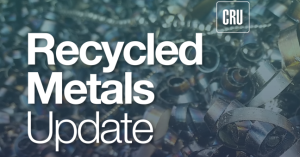
Scrap prices fall in June, with busheling tumbling $30/gt
Domestic scrap prices have fallen in June for all grades tracked by SMU, with prime scrap sinking $30 per gross ton (gt) from May, according to scrap sources.

Domestic scrap prices have fallen in June for all grades tracked by SMU, with prime scrap sinking $30 per gross ton (gt) from May, according to scrap sources.

The chatter about the June ferrous scrap market has been noticeably muted as we come off the Memorial Day weekend.

The spread between hot-rolled coil (HRC) and prime scrap prices narrowed this month, according to SMU’s most recent pricing data.
Domestic scrap prices this month are flat for prime material, but down for HMS and shredded, scrap sources told SMU.
What a difference a month makes. In late March, it seemed like the US hot-rolled (HR) coil market was poised to cycle upward. Large buyers had re-entered the market and placed big orders earlier in the month. Several outages were underway or upcoming. And expectations were that lead times would continue to extend. Cliffs said […]

The spread between hot-rolled coil (HRC) and prime scrap prices has widened this month after narrowing for three months, according to SMU’s most recent pricing data.

You might have noticed that SMU has been publishing more articles about scrap in recent months. That was no accident. In fact, we’ve found enough of an audience that CRU, our parent company, has decided to launch a new publication – Recycled Metals Update, or RMU. It cover both ferrous and nonferrous scrap. RMU’s website is here. You can go there now and request a 30-day free trial. It’s that simple.
SMU latest' steel market survey paints the picture of sheet market that has hit bottom and begun to rebound. Lead times are extending again after stabilizing earlier this month. Mills are far less willing to negotiate lower sheet prices - even if there are still deals to be had on plate, according to the steel buyers we canvassed.
Cleveland-Cliffs Inc. has plans to replace the blast furnace at its Middletown Works in Ohio with a direct-reduced iron (DRI) plant and two electric melting furnaces (EMFs).
Are we still looking for a bottom on sheet prices? In what direction are steel and scrap prices headed? How’s demand holding up at the moment?
The spread between hot-rolled coil (HRC) and prime scrap prices has narrowed for the third consecutive month in March, according to SMU’s most recent pricing data.

The ferrous scrap market experienced a sharp decline for March shipments. Prime scrap fell $60-70 per gross ton (gt) while shredded and other obsolete grades declined $40-50/gt. It seems these prices were accepted in the trade by dealers across the continent.
US ferrous scrap prices fell steeply in March for HMS, shredded, and prime scrap, sources told SMU.
A Detroit-area mill entered the scrap market on Thursday offering down $70 per gross ton (gt) on #1 busheling. And Nucor announced a minimum base price of $825 per short ton (st) for hot-rolled (HR) coil. What's the best way to interpret would could be read as contradictory trends?
A Detroit area steelmaker this morning announced its offers for scrap for March scrap shipments. The drop in its offer prices were larger than most industry observes forecasted, especially for shredded scrap. Many in the scrap community had predicted that prime scrap would drop $40-50 per gross ton (gt) with shredded only down $30-40/gt. But other market participants were skeptical about these predictions given bearishness in ferrous markets, both domestically and abroad.
Everyone knows the old saying that “a picture is worth a thousand words.” Just because it’s a cliché doesn’t mean that it’s wrong. A lot of inked has been spilled trying to figure out why prices are falling now. I thought it might be as simple as this: Market dynamics in the fourth quarter (UAW strike, companies buying ahead of an anticipated post-strike price spike, etc.) pulled forward restocking activity that typically happens in the first quarter.
What's the steel market talking about at present?

The spread between hot-rolled coil (HRC) and prime scrap prices narrowed further this month, according to SMU’s most recent pricing data.

US busheling scrap prices fell this month, while HMS and shredded grades remained largely unchanged.
Algoma Steel is currently navigating a challenge as it deals with an unplanned outage at its blast furnace, but the company’s CEO is still bullish on its future as an EAF steelmaker.
Steel Dynamics Inc. faces rising costs for its Columbus, Miss., aluminum rolling mill, but the project timeline remains on track.
The capacity for EAF steelmaking is growing both in the US and abroad. Ferrous scrap supply has never been more important. A lot of people have viewed the scrap industry as old-fashioned and resistant to change. However, the same forces affecting the steel and other industries are also at play in recycling.
This latest SMU steel market survey is a snapshot of a sheet market inflecting lower. A significant 43% of survey respondents said that the hot-rolled (HR) coil market has already peaked. Compare that to only 8% when we released our last steel market survey on Jan. 5.

The spread between hot-rolled coil (HRC) and prime scrap prices narrowed slightly this month, according to SMU’s most recent pricing data.
Domestic scrap prices ended up down slightly after a roller coaster of trading in January, scrap sources told SMU.
I expected that we’d start off January with prime scrap prices modestly up if for no other reason than industrial activity typically slows down over the holidays. And mills’ appetite for scrap typically increases in anticipation of stronger Q1 order activity.
I’d have been surprised if anyone told me just last week that the January scrap market might move lower. What we saw on Friday were offers. Not settlements. And no doubt there are still some twists and turns in store before we can say for sure which way scrap will go.
A Detroit-area mill entered the scrap market on Friday afternoon with the following offers: The Chicago area followed suit: Mills in the Great Lakes region sensed there was ample supply of most grades. Also, they all bought heavily last month and so had sufficient inventories to make this move, market participants said. Still, the move surprised […]
SMU polled steel buyers on a variety of subjects this past week, including purchasing practices, steel sheet prices, scrap, and the future market.
SMU doesn’t do forecasts. We leave that to our colleagues at CRU. But we’re pretty good at surveys, and we’ve got a great group of readers. That’s why we decided to ask you what’s in store for 2024. The results are below, along with some insightful comments in italics.